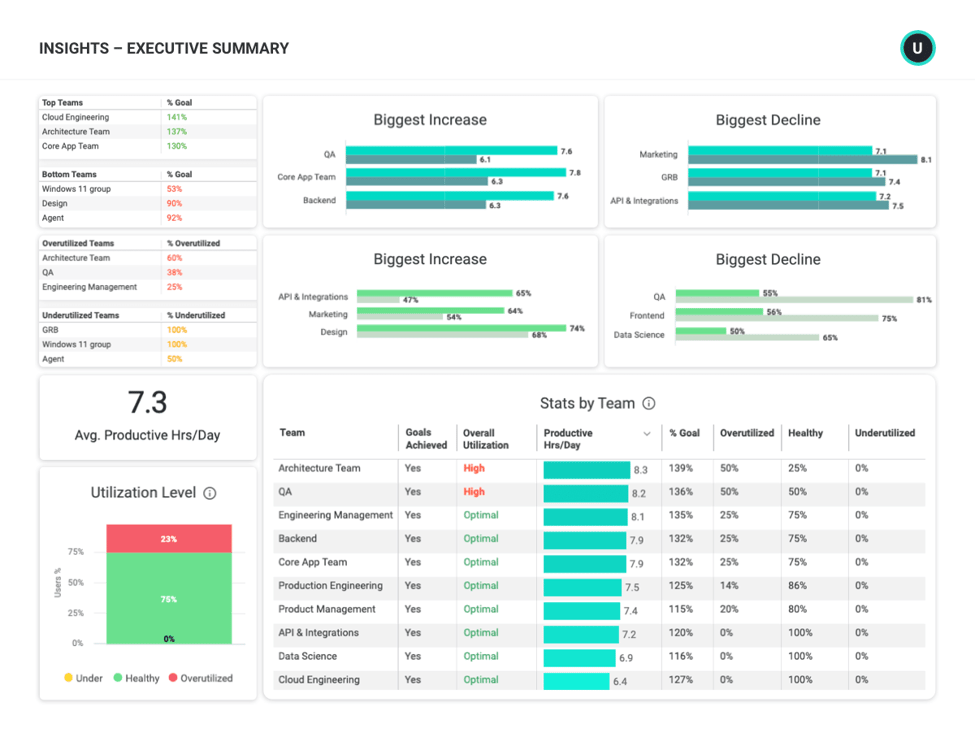The most reliable indicator of post-pandemic productivity might not exist yet. As companies finalize plans for a return to the office, remote work, or hybrid approach, there is an opportunity to collect data around productivity and workforce behavior to make more informed decisions around people, processes, and technology. For organizations that are already back in action in their long-term operating models, timely and robust data can validate any feedback or assumptions about the success of the transition, and track stability for the future. Wherever you are in your workplace journey, leveraging a productivity baseline is a powerful measurement strategy and key step in preserving business continuity during times of change.
What is a productivity baseline? Why is it important?
A productivity baseline serves as a point of reference for identifying deviations, highlighting best practices, and tracking performance over time. Ideally, it is captured over an extended period of time to account for variability for the most accurate future comparison. Now more than ever though, those circumstances aren’t always realistic. Since stasis can be hard to predict and even harder to maintain, aim to capture your productivity baseline during a period of time that has fewer known disruptive events (e.g., significant organizational changes, busy seasons, or major planned announcements). While establishing a productivity baseline is a time-sensitive priority, it is just one step in building a culture of continuous productivity improvement.
Why is now the right time?
Organizations and individuals showed incredible resilience and agility when forced to change their ways of living and working over the past year (with different rates of adjustment to new norms and environments). With regional variance, there were not any options for working from traditional and non-traditional third places such as coffee shops, libraries, and coworking spaces. There were not “things” to do throughout the day such as appointments, errands, and travel. As the work-life ecosystem created by Covid is evolving and the realities of everyday life recalibrate, it is important to have clarity and insight around how people are working. A productivity baseline captured at the right time (now), shows where you are today so you can make informed decisions, track changes over time, and course-correct when needed.
What tools do we need to do this effectively?
Competitive pressures and the realities of making decisions about a new operating model (e.g., in-office, remote, or hybrid), require a quick turnaround for landing on a productivity baseline today. Challenges and constraints such as availability of data, access to tools, and the need for buy-in could impact the timeline. Consider establishing an interim baseline with key points for comparison – enough to form a reasonably accurate understanding of performance across the organization and create a point of reference for observing and analyzing trends.
To ensure that your interim baseline produces useful, actionable information, focus exclusively on measuring the inputs and behaviors that have the most direct link to your team or organization’s performance. This may sound daunting, but productivity tools, such as ActivTrak, can expedite and streamline the process by collecting data and surfacing insights on an ongoing basis.
While it is a fixed point of reference by design, a productivity baseline could be variable across the organization based on the unique operating styles and business requirements of each team or individual. Within ActivTrak, the Dashboard, Insights, and Reports are configurable to showcase data across different time frames to highlight variation over time. For most users, a productivity baseline will be clearly identifiable and validated within 4 weeks. The productivity baseline, and other benchmarks, serve as guidelines for setting your team’s goals.

What can we expect to learn from a productivity baseline?
Deviations from your productivity baseline can reveal high performers, flag individuals in need of coaching, and provide early indicators of burnout risk. Having these at-a-glance points of reference can amplify best practices, support intervention, and accelerate resolution. Without a productivity baseline, untapped potential missed opportunities, and unmitigated risks lead to greater productivity loss over time and negatively impact all levels of the organization. It is important to remember that while there are likely organization-wide standards and expectations, productivity baselines can be unique to each team and, in some cases, each role or individual. Goal setting and benchmarks can be customized accordingly for more meaningful measurements and can be reevaluated as teams grow or change.
What’s next?
Sorting through the competing predictions about the future of work is overwhelming and the value and veracity of articles vary. In a 2020 article with a shareable, declarative headline, “Research: Knowledge Workers are More Productive from Home,” I was surprised to learn that the point of comparison was replicated research from 2013. There have been significant technological advancements and cultural shifts in the 7 years between studies that add critical context (most notably, the explosive growth of cloud computing). Some of the most successful, category-creating, collaboration and productivity tools and services used today did not exist in 2013 which would understandably impact the workstyle and self-reported productivity of participants, independent of where they are working. The most reliable indicator of post-pandemic productivity is your own productivity baseline.
Improving productivity starts with collecting the right data, at the right time, with the right tools. Consider methodologies like ActivTrak for generating reliable, relevant productivity baselines at the organizational, team, and individual levels. Our workforce analytics provide real-time insights as you iterate approaches to new ways of working.
About ActivTrak and The Productivity Lab
ActivTrak helps companies unlock productivity potential. Our award-winning workforce productivity and analytics software provides expert insights that empower people, optimize processes, and maximize technology. With data sourced from more than 9,500 customers and 250,000 users, ActivTrak’s Productivity Lab is a global center for ground-breaking workforce productivity research and expertise that helps companies embrace and embody the future of work.




